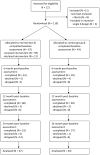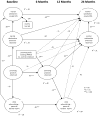Effects of the Oregon model of Parent Management Training (PMTO) on marital adjustment in new stepfamilies: a randomized trial
- PMID: 20731495
- PMCID: PMC2928579
- DOI: 10.1037/a0020267
Effects of the Oregon model of Parent Management Training (PMTO) on marital adjustment in new stepfamilies: a randomized trial
Abstract
Effects of intervention with the Oregon model of Parent Management Training (PMTO) on marital relationship processes and marital satisfaction in recently married biological mother and stepfather couples were examined. Sixty-seven of the 110 participating families were randomly assigned to PMTO, and 43 families to a non-intervention condition. Intervention had reliable positive indirect effects on marital relationship processes 24 months after baseline which in turn were associated with higher marital satisfaction. These indirect effects were mediated by the impact of PMTO on parenting practices 6 months after baseline. Enhanced parenting practices resulting from PMTO prevented escalation of subsequent child behavior problems at school. Consistent with a family systems perspective and research on challenges to marital quality in stepfamilies, improved co-parenting practices were associated with enhanced marital relationship skills and marital satisfaction as well as with prevention of child behavior problems.
Figures


References
-
- Achenbach TM. Manual for the Child Behavior Checklist/4–18 and the 1991 Profile. Burlington, VT: University of Vermont, Department of Psychiatry; 1991.
-
- Arbuckle J, Worthke W. Amos 4.0 user’s guide. Chicago, IL: SmallWaters Corporation; 1999.
-
- Bakeman R, Gottman JM. Observing interaction: An introduction to sequential analysis. New York: Cambridge University Press; 1986.
-
- Baron RM, Kenny DA. The moderator-mediator variable distinction in social psychological research: Conceptual, strategic, and statistical considerations. Journal of Personality and Social Psychology. 1986;51:1173–1182. - PubMed
-
- Bray JH. Children’s development during early remarriage. In: Hetherington EM, Aresteh JD, editors. Impact of divorce, single parenting, and step parenting on children. Hillsdale, New Jersey: Erlbaum; 1988. pp. 279–299.

